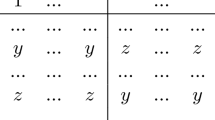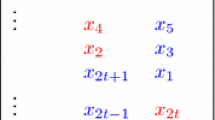Abstract
We study the problem of assigning objects to a set of agents. We focus on probabilistic solutions that only take agents’ preferences over objects as input. Importantly, agents may be indifferent among several objects. The “extended serial correspondence” is proposed by Katta and Sethuraman (J Econ Theory 131:231–250, 2006) to solve this problem. As a follow-up to Liu and Pycia (Ordinal efficiency, fairness, and incentives in large markets. Mimeo, 2012) who introduce the notion of profiles with “full support”, we work with two interesting classes of preference profiles: profiles that (i) have rich support on a partition or (ii) are single-peaked with rich support on a partition. For each profile in these classes, an assignment matrix is selected by the extended serial correspondence if and only if it is sd-efficient and sd envy-free. We also provide an asymptotic result.

Similar content being viewed by others
Notes
Hashimoto and Hirata (2011), Heo (2011) and Kesten et al. (2011) are the first papers characterizing the serial rule. Hashimoto et al. (2013) evolved from Hashimoto and Hirata (2011) and Kesten et al. (2011), sharpening the result of Bogomolnaia and Heo (2012). Heo (2011) generalizes the model to accommodate the possibility that agents receive more than one object.
If there is no such tier-structure within the set of schools, then the partition has to be composed of single component, \(A\). If preferences are perfectly correlated, then the partition has to be such that the cardinality of each component is one. Such a tier structure among colleges is often publicly published as well. For example, see U.S. News and World Report at http://www.usnewsuniversitydirectory.com/undergraduate-colleges/national-universities.aspx.
For the formal definition of these conditions, see Sect. 3.
Formally, given any two sequences of rules, say \((\phi ^\nu )_{\nu \in \mathbb N _+}\) and \((\varphi ^\nu )_{\nu \in \mathbb N _+}\), the assignment matrix selected by \(\phi ^\nu \) converges to the one selected by \(\varphi ^\nu \) as \(\nu \rightarrow \infty \). Liu and Pycia (2012) impose a mild assumption of “regularity” on these sequences.
The set of objects may include the “null object”, \(\emptyset \), which represents not receiving any object in \(A\setminus \{\emptyset \}\). The number of copies of the null object is equal to the number of agents: \(q_{\emptyset }=|N|\).
Formally, it should be \(o^k(P_i)\), but for simplicity, we omit \(P_i\), unless otherwise specified.
Equivalently, the supply of the last object(s) in \(B\) reaches exhaustion at \(\tau \).
Katta and Sethuraman (2006) show that on the weak preference domain, no solution satisfies sd-efficiency, sd no-envy, “weak sd strategy-proofness”, which requires that, given any preference profile of the other agents, no agent should ever be sd better off by misreporting his preferences. Even if we restrict our attention to the single-peaked preference domain, this impossibility still holds. To see this, consider the following example. Let \(A\equiv \{a,b,c,d\}, N\equiv \{1,2,3,4\}, q=(1,1,1,1)\), and \(R\in \mathcal R ^N_A\) be such that \(R_1: b~(a,c)~d, R_2=R_3: b~c~a~d\), and \(R_4: b~c~d~a\), where the equally desirable objects are represented in the parenthesis. The profile is single-peaked with respect to \(a\prec b\prec c\prec d\). Let \(\pi \in \Pi \) be an sd-efficient and sd envy-free matrix. It is easy to check that \(\pi _1=(\frac{5}{9}, \frac{1}{4},0, \frac{7}{36})\). Suppose that the preference of agent 1 changes to \(R_1^{\prime }:b~c~a~d\). The resulting assignment \(\pi _1^{\prime }\) has to be \((\frac{1}{3}, \frac{1}{4}, \frac{1}{4}, \frac{1}{6})\), which stochastically dominates \(\pi _1\) at \(R_1\), in violation of weak sd strategy-proofness. I thank the referee for pointing out the strategic issue on this domain.
Formally, \(b\) is the object such that (i) if \(M(R_j,A_m)\prec _{A_m}\bar{a}\), then for each \(o\in U(R_j,\bar{a})\setminus \{b\}, b\prec _{A_m}o\), and (ii) if \(\bar{a}\prec _{A_m} M(R_j,A_m)\), then for each \(o\in U(R_j,\bar{a})\setminus \{b\}, o\prec _{A_m}b\).
If there is no such pair, \(\epsilon ({{\bar{\nu }}})=0\), and we are done.
That is, we cannot make some agent sd better off without making someone else sd worse off, by increasing his consumption of \(I(R_i^{{{\bar{\nu }}}}, a)\) by \(\epsilon ({{\bar{\nu }}})\) and decreasing his consumption of the objects to which he prefers \(a\) by the same amount in total.
For the detail, see Case 2 in the proof of Theorem 1.
References
Birkhoff G (1946) Three observations on linear algebra. Revi Univ Nac Tucuman Ser A 5:147–151
Black D (1958) The theory of committees and elections. Cambridge University Press, Cambridge
Bogomolnaia A, Moulin H (2001) A new solution to the random assignment problem. J Econ Theory 100:295–328
Bogomolnaia A, Heo EJ (2012) Probabilistic assignment of objects: characterizing the serial rule. J Econ Theory 147:2072–2082
Foley D (1967) Resource allocation and the public sector. Yale Econ Essays 7:45–98
Hashimoto T, Hirata D (2011) Characterizations of the probabilistic serial mechanism. Mimeo
Hashimoto T, Hirata D, Kesten O, Kurino M, Ünver U (2013) Two axiomatic approaches to the probabilistic serial mechanism. Theor Econ (forthcoming)
Heo EJ (2011) Random assignment problem with multiple demands: a generalization of the serial rule and a characterization. Mimeo
Heo EJ, Yılmaz Ö (2012) A characterization of the extended serial correspondence. Mimeo
Kandori M, Kojima F, Yasuda Y (2010) Tiers, preference similarity, and the limits on stable partners. Mimeo
Katta AK, Sethuraman J (2006) A solution to the random assignment problem on the full preference domain. J Econ Theory 131:231–250
Kasajima Y (2012) Probabilistic assignment of indivisible goods with single-peaked preferences. Soc Choice Welfare (forthcoming)
Kesten O (2010) School choice with consent. Q J Econ 125:1297–1348
Kesten O, Kurino M, Ünver U (2011) Fair and efficient assignment via the probabilistic serial mechanism. Mimeo
Liu Q, Pycia M (2012) Ordinal efficiency, fairness, and incentives in large markets. Mimeo
Moulin H (1980) On strategy-proofness and single peakedness. Pub Choice 35:437–455
Sprumont Y (1991) The division problem with single-peaked preferences: a characterization of the uniform allocation rule. Econometrica 59:509–519
Thomson W (2010a) Consistency for the probabilistic assignment of objects. Mimeo
Thomson W (2010b) Strategy-proof allocation rules. Mimeo
Von Neumann J (1953) A certain zero-sum two-person game equivalent to the optimal assignment problem. In: Kuhn HW, Tucker AW (eds) Contributions to the theory of games, vol 2. Princeton University Press, Princeton, pp 5–12
Author information
Authors and Affiliations
Corresponding author
Additional information
I am grateful to William Thomson for his support and encouragement. I also benefited from useful comments from Anna Bogomolnaia, Fuhito Kojima, Qingmin Liu, Vikram Manjunath, Marek Pycia, and seminar audience at Columbia University in October 2011.
Rights and permissions
About this article
Cite this article
Heo, E.J. The extended serial correspondence on a rich preference domain. Int J Game Theory 43, 439–454 (2014). https://doi.org/10.1007/s00182-013-0388-4
Accepted:
Published:
Issue Date:
DOI: https://doi.org/10.1007/s00182-013-0388-4
Keywords
- Sd-efficiency
- Sd no-envy
- Rich support on a partition
- Single-peaked preference profiles with rich support on a partition
- The extended serial correspondence




